I’ve seen a couple of other leucistic Red-winged Blackbirds in the past but none were as boldly marked as this one.
Yesterday afternoon, during a slight break in our blustery, snowy, windy weather, I visited some of our local ponds to look for any interesting birds that might be moving through. I found several of them but the one I found most interesting was a leucistic adult male Red-winged Blackbird that stood out like the proverbial sore thumb.
First, because some readers might not be very familiar with Red-winged Blackbirds, let’s see what the vast majority of adult males look like.
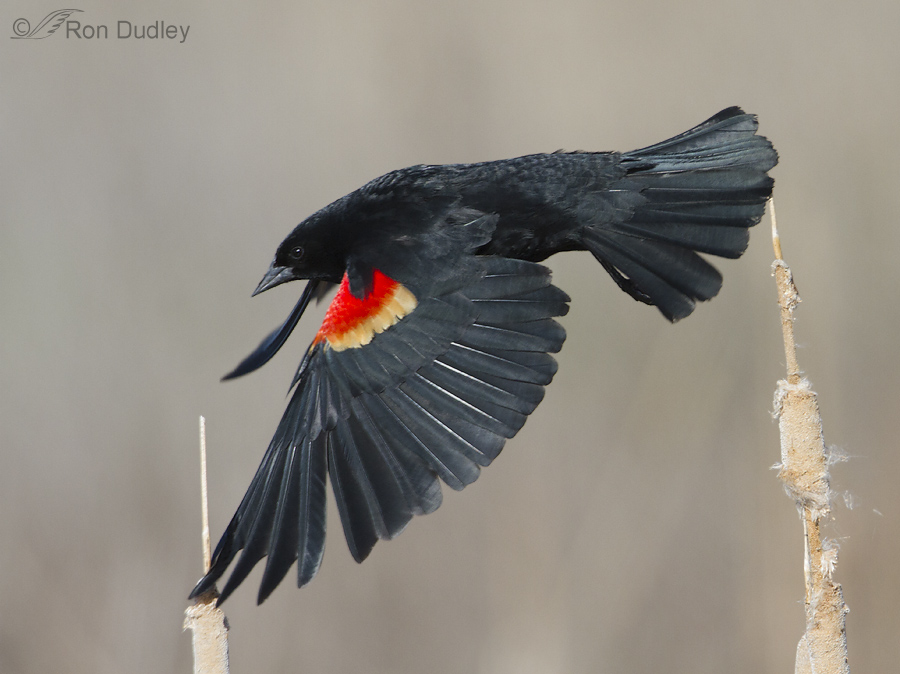
Adult males are glossy black with epaulets of red bordered with yellow on the wrist (bend) of the wing. Normally there isn’t a speck of white in their plumage, other than the shiny rachis (shaft) of primary feathers that can appear almost white in the right light.
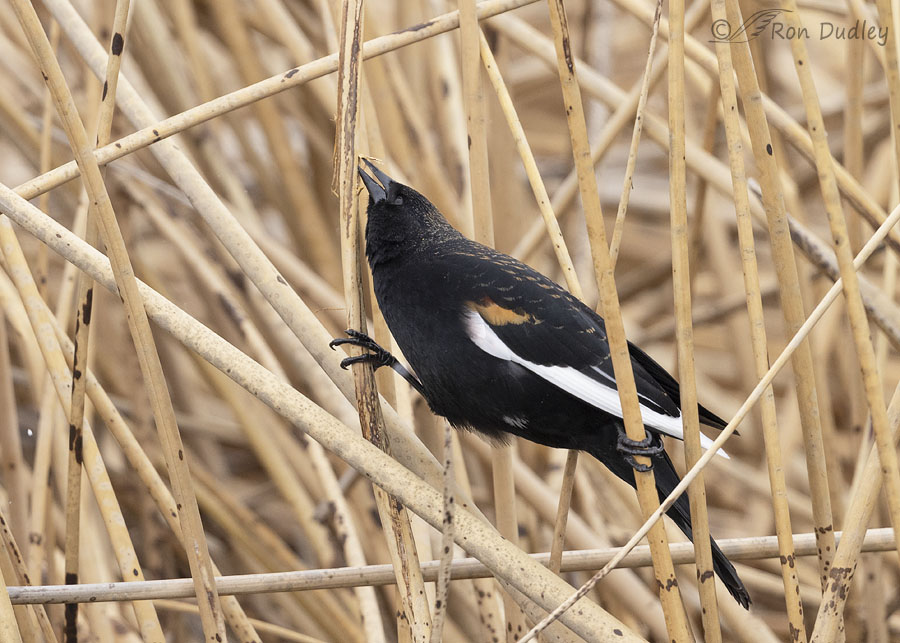
1/1250, f/5.6, ISO 800, Canon R5, Canon EF500mm f/4L IS II USM + 1.4 tc, not baited, set up or called in
And that’s why this guy caught my eye yesterday afternoon. This is one of the first shots I got of him as he appeared to be looking for early-emerging insects on a phrag stem. Even with his wings folded his white primaries stood out in an almost shocking manner.
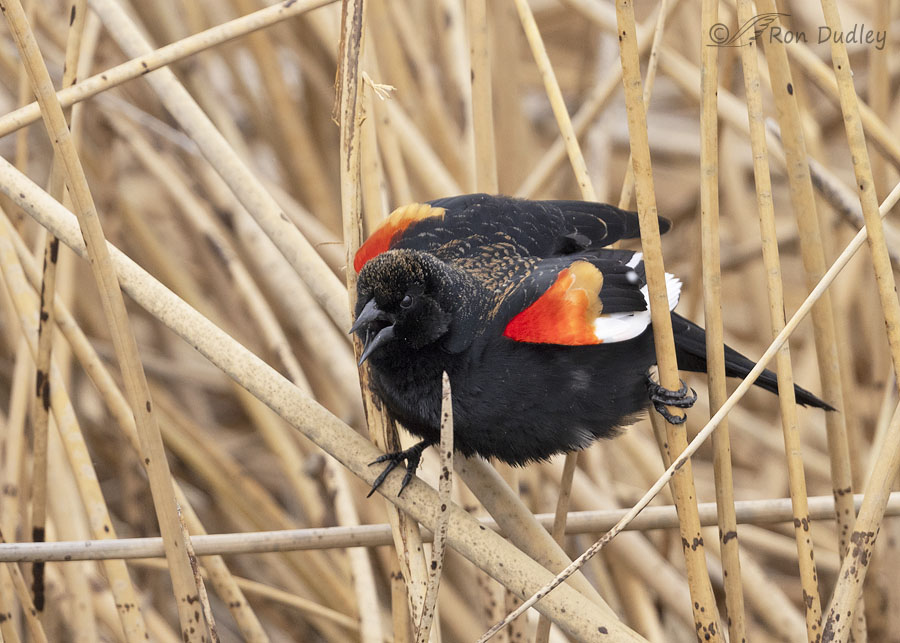
1/1250, f/5.6, ISO 800, Canon R5, Canon EF500mm f/4L IS II USM + 1.4 tc, not baited, set up or called in
For a few moments he seemed intent on displaying his red and yellow epaulets while singing, as if to prove that he had more going for him than just white primaries.
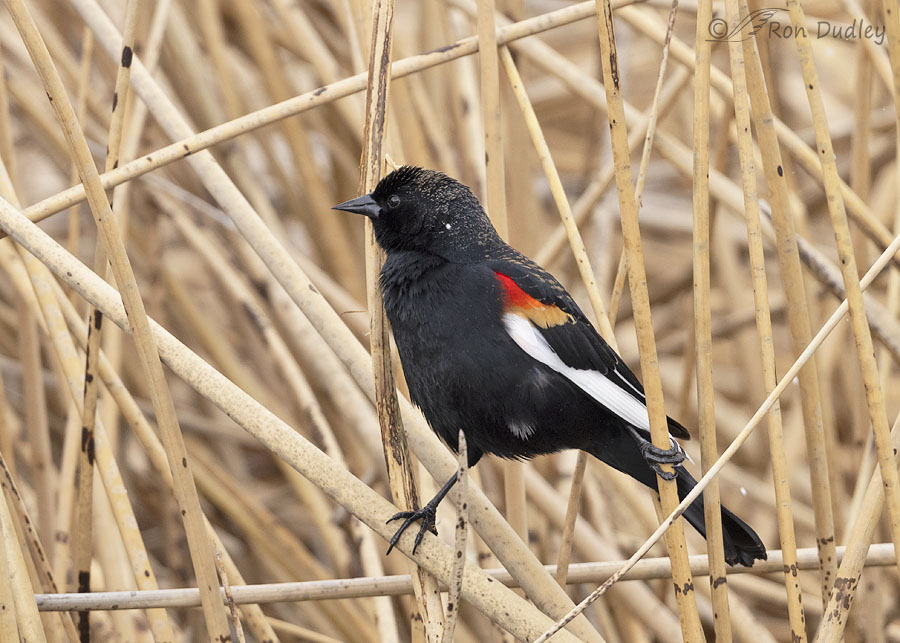
1/1250, f/5.6, ISO 800, Canon R5, Canon EF500mm f/4L IS II USM + 1.4 tc, not baited, set up or called in
For the few seconds I had him in my viewfinder the light was awful. It was actually snowing when I took these photos, as evidenced by the snowflakes in front of his upper neck and near the end of his tail.
I really wanted to see his left wing open so I could tell more precisely how much of that wing was white. But in this light, when he took off my active focus point was unable to track him so the ‘best’ shot I got was soft. So soft it’ll probably make your eyes water as you try to bring it into focus.
But I’m going to include it anyway because it’s the only photo I got that shows the true extent of his leucism.
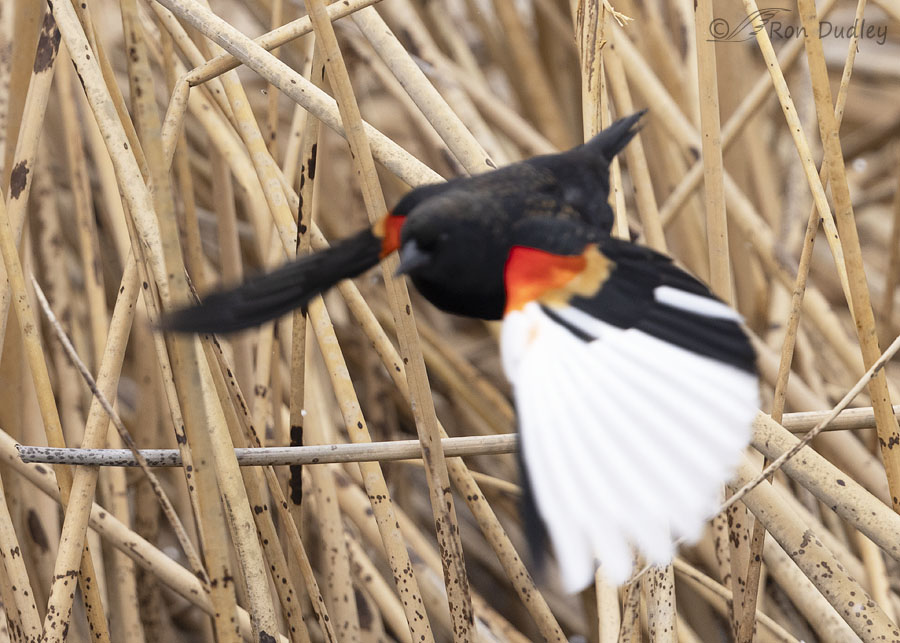
1/1250, f/5.6, ISO 800, Canon R5, Canon EF500mm f/4L IS II USM + 1.4 tc, not baited, set up or called in
I think the leucism pattern in his left wing is really interesting.
Red-winged Blackbirds have ten primaries and nine secondaries. It appears to me that his outermost primary is black and the rest are as white as the driven snow, except for a proximal portion of one of them. And the distal portion of one of his secondaries is also white. In other photos I could tell that the rest of his body, including his right wing, is covered with normally colored feathers.
I think leucism, especially in birds, is fascinating. Which explains why I was so disappointed when this last shot turned out to be disgustingly soft.
Ron


In all the articles I have read I have never heard the term lucecism. In the 6 mammals and birds I have viewed that were all white or partially white I assumed it was albinoism. When I was in Kansas pheasant hunting there was a flock of several hundred blackbirds with one all white. As the flock ungelated in the late afternoon sky the white one stayed in the center of the flock as they moved about. It was mesmerizing. I have viewed one melenistic gopher my short-hair pointer caught alive. I held in by the nape of the neck and observed it for awhile. It was almost jet black. Nature is awesome.
A striking bird, that! I hope you get to see him again.
I hope so too.
I am late in posting, but thanks for the posting and information once again. Never would have guessed they had so much white in the wings.
“Never would have guessed they had so much white in the wings.”
Most of them don’t, Trudy. It’s highly unusual in this species.
And don’t worry about commenting “late”. I appreciate comments no matter when they’re posted.
These guys are flashy as it is, but with those white feathers…wow!
Agreed.
Sorry about the last shot, it would’ve been a stunner with those white feathers. Very neat find, maybe you’ll get a retry?
“maybe you’ll get a retry?”
I could, April. If he hangs around. Last year a less spectacularly marked leucistic RWBB hung around my feeder for nearly a week.
Love it when you teach us a new word: leucistic. Thank you for the link that explains the difference between leucistic and albinism. Fascinating! That boy is certainly handsome!
Thank you, Kathleen.
Fascinating post Ron. I have never seen leucism in the wild as far as I can recall, and never thought about what it would look like in a red-winged.
Hard to tell from the post, but is it only the left wing that has white feathers, or were there some in the right wing as well? At the very least, they don’t seem symmetric in color.
Bill, his right wing is normally colored. Which is why I said he was “unilaterally leucistic” in my title.
Ahh, I didn’t register the “unilaterally” on first read. A new phrase to add to my vocabulary 🙂 Thanks for pointing it out!
No problem at all.
Really neat, very dashing! Thanks for including the flying one, even though it pained you. The brown speckling on his head/upper back – is he just not in full breeding plumage yet? And does the leucism affect viability of any eggs he fertilizes?
Carolyn, when they’re still fairly young some males are black with brown flecks. I imagine the “brown speckling” is due to that.
I doubt his leucism affects his ferrtility.
Wowzers! What a coolamatious bird — fabulous markings! Looks like he may have a little white belly feather too.
He also seems to be cosplaying as a Golden with all those bronze feathers on his head and upper back. So glad you included the last shot (I know it hurt to do it), even though Ol’ Murph was at it again.
I hope there’s a female RWB out there that likes some extra flash. I’d love to see what his kids will look like!
“I’d love to see what his kids will look like!”
So would I, Marty. It might satisfy our shared curiosity.
Stunning Photos ! While enjoying them, I suddenly remembered a
Novel, “The Painted Bird”( author Jerzy Kosinski) in which the
premise was that a bird colored so differently from others of its
species would be attacked by them– doesn’t seem to be true, at least
in this case. Have you ever witnessed such a thing ?
“Have you ever witnessed such a thing ?”
I haven’t, Kris. In my experience, birds that are unusual in some way still seem to be accepted by others of the same species.
Another great educational gift – thanks so much! Given the odds, you won this lottery.
Thanks, Burrdoo. About time I won something…
Very interesting Ron – I am not positive but I think I first learned the term and definition here on FP. I never remember ever seeing an leucistic Red-winged Blackbird.
Thanks, Everett. Good to know you’re learning stuff here.
WOW! Very interesting pattern that the “soft” photo shows well……. 🙂 Something goes haywire in so many different ways when it comes to that.
Leucistic finch is still showing up here every few days – may every day but I’m not out watching all the time. 1 in 30,000 does make the odds of encountering one pretty amazing.
Judy, “Haywire” is my middle name…
Great catch of an unusual fellow. The distinction between the red and yellow on his left epaulet doesn’t seem as marked as most males. The last shot is a great help in understanding his coloring. Wonder what the females will think about him when they get there.
“Wonder what the females will think about him when they get there.”
I had the same thought, Pam. But I doubt they’ll treat him any differently.
I’m with Brett. You had to include that last one. It really brings the point home. So fascinating. Thanks professor.
A quick Google tells me that the incidence of “leucism and albinism occur at a rough estimate of 1 in 30,000 birds”.
With that kind of luck you should go out and buy a lottery ticket!
““leucism and albinism occur at a rough estimate of 1 in 30,000 birds”.
That puts it in perspective, doesn’t it Michael. Thanks for including that little tidbit in your comment.
I’ve never bought a lottery ticket in my life. Well, I did once but it was because my mother-in-law shamed me into doing it.
Thanks for including the soft shot for illustration. A good teaching moment!
Brett, as you probably know it goes against my grain to post a shot that soft but it had to be done. Glad you appreciated it. Thanks.
Beautiful, fancy bird! That last photo must have been disappointing… I get many of those.
“Fancy bird”. I like that, Joanne.